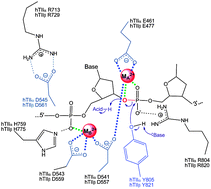The use of divalent metal ions by type II topoisomerases
Abstract
Type II topoisomerases are essential enzymes that regulate

Maintenance work is planned for Wednesday 1st May 2024 from 9:00am to 11:00am (BST).
During this time, the performance of our website may be affected - searches may run slowly and some pages may be temporarily unavailable. If this happens, please try refreshing your web browser or try waiting two to three minutes before trying again.
We apologise for any inconvenience this might cause and thank you for your patience.
* Corresponding authors
a Department of Pharmaceutical Sciences, Lipscomb University College of Pharmacy, Nashville, Tennessee 37204-3951, USA
b Department of Biochemistry, Vanderbilt University School of Medicine, Nashville, Tennessee 37232-0146, USA
c
Department of Medicine (Hematology/Oncology), Vanderbilt University School of Medicine, Nashville, Tennessee 37232-0146, USA
E-mail:
neil.osheroff@vanderbilt.edu
Fax: +1 615-343-1166
Tel: +1 615-322-4338
Type II topoisomerases are essential enzymes that regulate

 Please wait while we load your content...
Something went wrong. Try again?
Please wait while we load your content...
Something went wrong. Try again?
 Fetching data from CrossRef.
Fetching data from CrossRef.
This may take some time to load.
Loading related content
